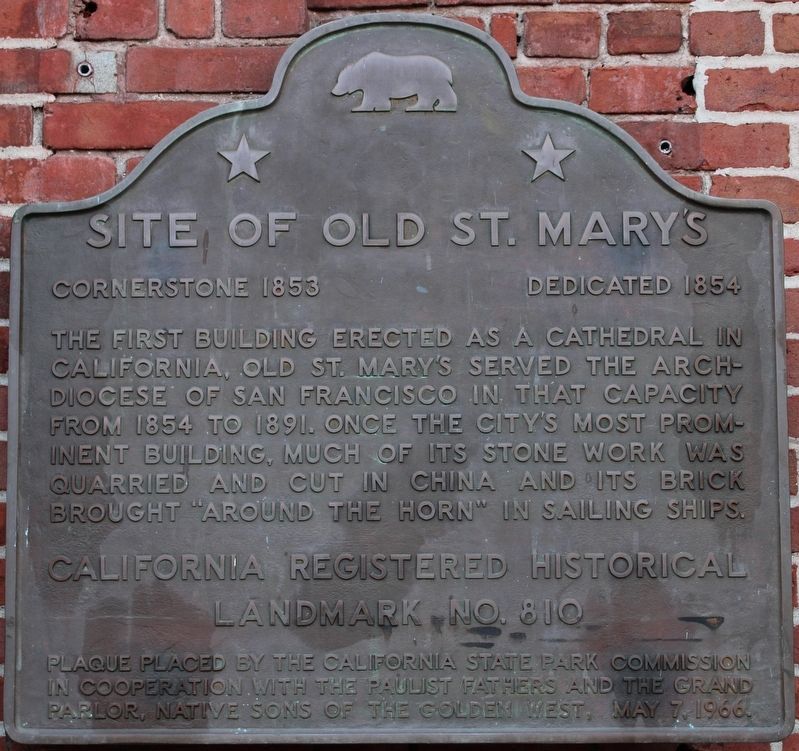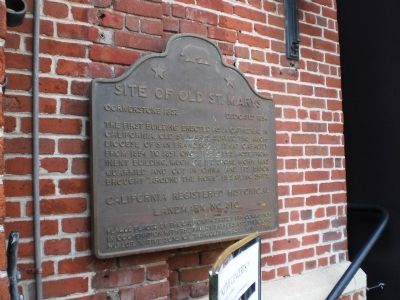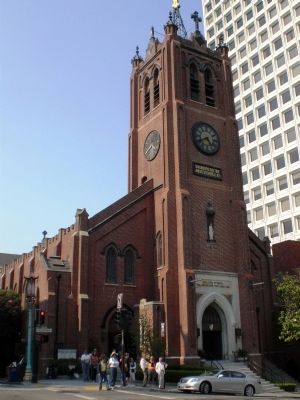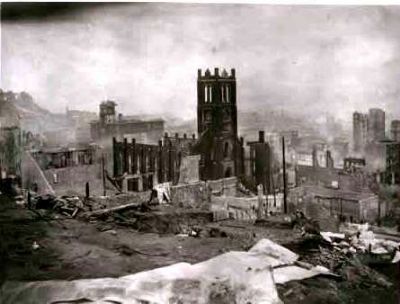Chinatown in San Francisco City and County, California — The American West (Pacific Coastal)
Site of Old St. Mary’s
Cornerstone 1853 - Dedicated 1854
California Registered Historical Landmark No. 810
Plaque placed by California State Park Commission in cooperation with the Paulist Fathers and the Grand Parlor of the Native Sons of the Golden West, May 7, 1966
Erected 1966 by California State Park Commission and the Paulist Fathers and the Grand Parlor of the Native Sons of the Golden West. (Marker Number 810.)
Topics and series. This historical marker is listed in these topic lists: Churches & Religion • Notable Buildings. In addition, it is included in the California Historical Landmarks, and the Native Sons/Daughters of the Golden West series lists. A significant historical month for this entry is May 1864.
Location. 37° 47.556′ N, 122° 24.346′ W. Marker is in San Francisco, California, in San Francisco City and County. It is in Chinatown. Marker is at the intersection of California Street and Grant Avenue, on the right when traveling west on California Street. Touch for map. Marker is at or near this postal address: 660 California Street, San Francisco, San Francisco CA 94108, United States of America. Touch for directions.
Other nearby markers. At least 8 other markers are within walking distance of this marker. Far East Café (within shouting distance of this marker); Dr. Sun Yat Sen (within shouting distance of this marker); Chinese-American War Memorial (about 300 feet away, measured in a direct line); First Chinese Baptist Church (about 400 feet away); Kong Chow Association and Temple (about 500 feet away); "Comfort Women" Column of Strength (about 500 feet away); Willie "Woo Woo" Wong (about 500 feet away); Home of Benjamen Chinn (about 500 feet away). Touch for a list and map of all markers in San Francisco.
Regarding Site of Old St. Mary’s. The following church history was transcribed from the display case in the church library, date and author unknown:
“The (old) Cathedral of St. Mary of the Immaculate Conception was erected in 1854 as the seat of the Archdiocese of San Francisco for the entire Pacific Coast. Pioneer banker and landowner John Sullivan, whose wife is buried in the crypt, had donated the site in 1853 to Archbishop Alemany in order that he could erect the first cathedral building in all California. Architects William Craine and Thomas England modeled the cathedral after a gothic church in Vich, in Archbishop Alemany’s native Spain. The cornerstone was laid on July 17, 1853, but work progressed slowly due to the loss of skilled workers to the gold fields and the lack of available building materials. Despite these setbacks the cathedral, the largest structure built in California until the end of the century, was dedicated at midnight mass on December 25, 1854.
Granite for the foundation and trim elements were quarried and cut in China, while the brick for the exterior walls was shipped from New England around the Horn and used as ballast on the ship. Only the sandstone used to trim the clock and the main entrance was quarried and cut locally. The interior was lavish, featuring vaulted ceilings with a series of plaster groin arches and a marble altar imported from Rome. As the decades passed, the changing neighborhood and the “Barbary Coast” required moving the cathredral to a safer and more respectable part of the city. With the dedication of the “new” Saint Mary’s Cathredral in 1891, the former cathedral became known as Old Saint Mary’s Cathedral.
The earthquake of 1906 caused little damage to Old Saint Mary’s. Two finials fell from the buttresses, as did the cross and pediment on the front of the church, crushing the granite steps of the main entrance; otherwise the building escaped unscathed. But the fire sweeping through the city after the earthquake gutted the church by midnight. However, the walls, with the exception of the rear gable that collapsed after the fire, remained intact, and neither the foundation nor the walls cracked or disintegrated. Popular opinion sided with then Paulist Pastor Father Wyman who called for rebuilding. He received support from the noted architect Willis Polk, who claimed that “to tear down the standing walls of Old Saint Mary’s was to tear down history itself.” Ultimately, the architects examining the site decided to reconstruct the church using the remaining structure. Archbishop Riordan rededicated the cathedral on Sunday, June 20, 1909.
The original building ended where the front pew is. In January 1929, architect Edward A. Eames added fifty feet to the building along Grant Avenue, constructing east and west transepts to create a cruciform floor plan and increasing the seating to 2000. (The current altar, Blessed Sacrament Chapel and sacristy wing is part of this construction.)
A fire in the attic above the main altar did considerable damage to the roof and interior of the building on January 11, 1966. Architect John Minton designed the repairs as well as some further interior remodeling. The church was reopened for service on Easter Sunday 1967. On May 7, 1966, the California State Landmarks Commission gave the cathedral official landmark status, and on March 6, 1968, the City and County of San Francisco designated the church its number two landmark.“
The church is currently undergoing a multi-year, multi-million dollar seismic retrofitting.
Also see . . .
1. Old Saint Mary's Parish website. (Submitted on July 15, 2008.)
2. Old St. Mary's Cathedral. Wikipedia entry. (Submitted on September 26, 2020, by Larry Gertner of New York, New York.)
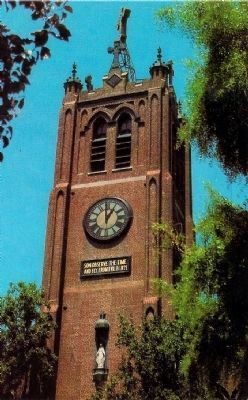
Photographed By Mike Roberts Color Productions, Smith Novelty Co. - San Francisco, circa 1983
4. Old St. Mary’s Church - San Francisco
Description on postcard:
Originally St. Mary's Cathedral - Dedicated December 25, 1854 - St. Mary's Church, June 11, 1891 - Paulist Fathers, December 8, 1894 - Destroyed by Fire April 18, 1906 - Rededicated June 20, 1909 - Enlarged to include Paulist Library in 1929.
Originally St. Mary's Cathedral - Dedicated December 25, 1854 - St. Mary's Church, June 11, 1891 - Paulist Fathers, December 8, 1894 - Destroyed by Fire April 18, 1906 - Rededicated June 20, 1909 - Enlarged to include Paulist Library in 1929.
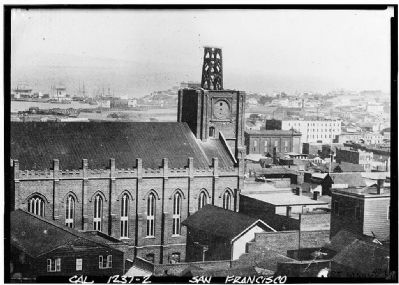
Photographed By George Robinson Fardon, 1854
5. Old St. Mary's - 1854
One of the 1850's commercial innovations in the developing field of photography was the publication of folios of photographs depicting a single city or region. G.R. Fardon arrived in San Francisco in 1849, and began photgraphing the rapidly developing city. Herre and Bauer published his photographs in the first compilation of photographs of any American city with their book, "San Francisco Album. Photographs of the Most Beautiful Views and Public Buildings of San Francisco.", in which this photo appeared.
Credits. This page was last revised on June 13, 2023. It was originally submitted on July 15, 2008, by Andrew Ruppenstein of Lamorinda, California. This page has been viewed 2,325 times since then and 59 times this year. Photos: 1. submitted on June 13, 2023, by Joseph Alvarado of Livermore, California. 2, 3. submitted on July 15, 2008, by Andrew Ruppenstein of Lamorinda, California. 4. submitted on May 18, 2010. 5, 6. submitted on July 15, 2008, by Andrew Ruppenstein of Lamorinda, California. • Kevin W. was the editor who published this page.
